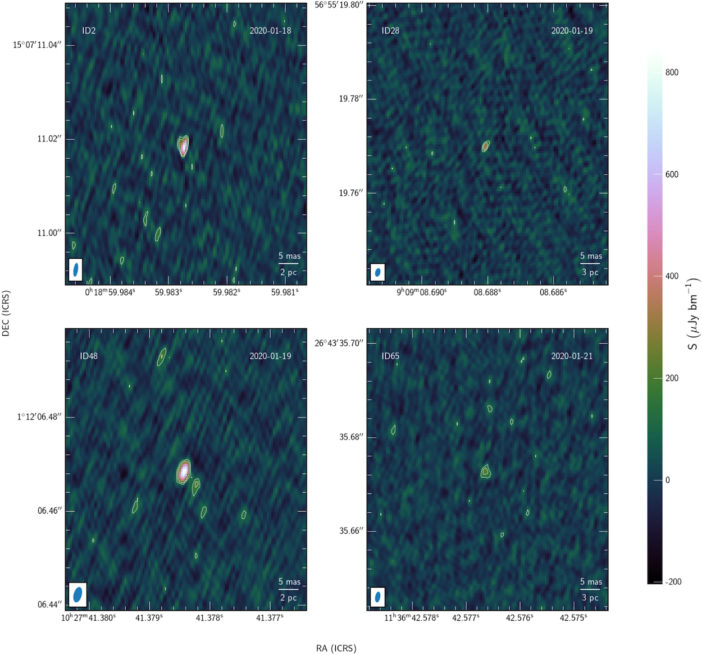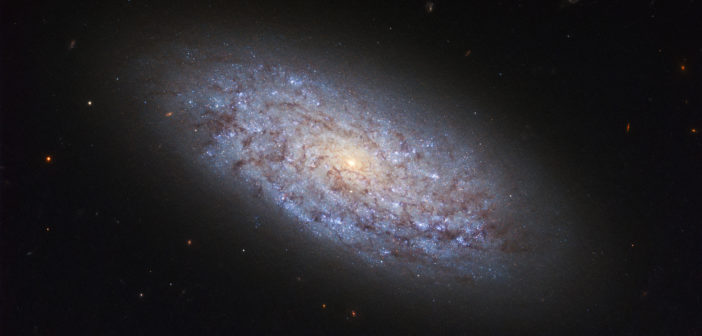Editor’s Note: Astrobites is a graduate-student-run organization that digests astrophysical literature for undergraduate students. As part of the partnership between the AAS and astrobites, we occasionally repost astrobites content here at AAS Nova. We hope you enjoy this post from astrobites; the original can be viewed at astrobites.org.
Title: Wandering Black Hole Candidates in Dwarf Galaxies at VLBI Resolution
Authors: Andrew J. Sargent et al.
First Author’s Institution: United States Naval Observatory and The George Washington University
Status: Published in ApJ
How do you make a black hole billions of times the mass of the Sun? Even for the planet-building Magratheans, this seems like a tall order. Plenty of mechanisms have been proposed to explain the formation of these supermassive black holes found at the centers of most galaxies. Some involve the mergers of “seeds” — massive black holes weighing in at merely hundreds to hundreds of thousands of solar masses. A simple way to test these theories is to search for relic massive black holes, and low-mass dwarf galaxies are excellent targets. Since dwarf galaxies haven’t undergone many mergers, any massive black holes they harbor should have avoided being gobbled up by growing supermassive black holes.
Today’s article studies 13 possible massive black hole candidates in dwarf galaxies, some of which may have wandered to the edges of their hosts. What’s up with that — and are they really massive black holes? Let’s dive in!
Here’s a question: since supermassive black holes are usually found near the center of their galaxies, why might we expect some massive black holes in dwarf galaxies to lie further out? The answer has to do with gravity: since dwarf galaxies are much less massive than the galaxies that host supermassive black holes, their gravitational potential is lower, making it easier for massive black holes to “wander” away from their centers. This means that if you see a radio source that appears far to the side of a dwarf galaxy’s center, it could be an massive black hole — or it could be an accreting supermassive black hole (an active galactic nucleus) in a galaxy far, far away that by chance simply happens to lie behind the dwarf galaxy. These unwanted interlopers can pose a challenge for identifying massive black holes.
Another issue with finding massive black holes is that they’re faint. While massive black holes go through periods of accretion like supermassive black holes, their low masses mean that they don’t accrete as quickly, reducing their luminosities. By the early 2000s, only two accreting black holes had been found in dwarf galaxies. Fortunately, this changed with the advent of sky surveys like the now famous Sloan Digital Sky Survey (SDSS), which has been running since 2000 and has amassed detections of close to a billion unique sources.
The 13 massive black hole candidates, shown in Figure 1, were assembled in an article from 2020 by some of the same astronomers who authored today’s article. In the 2020 article, the team sifted through 43,707 low-mass dwarf galaxies from SDSS, looking for sources that had been detected at radio frequencies by the Very Large Array. After keeping the matches and eliminating the radio sources that were background active galactic nuclei or could be explained by processes related to star formation, the team ended up with 13 massive black hole candidates, many of which aren’t aligned with the centers of their host galaxies.

Figure 1: The 13 dwarf galaxies hosting possible massive black hole candidates, as seen by the Dark Energy Camera Legacy Survey at optical wavelengths. The red crosses show the location of the compact radio sources that may be massive black holes. While some appear close to their host’s center, others are significantly farther away. [Reines et al. 2020]

Figure 2: The four sources the team was able to detect with the VLBA. Here, S is flux density, a quantity that describes the intensity of radio emission. As these sources are actually background active galactic nuclei rather than massive black holes in the targeted dwarf galaxies, the physical scales in the lower right are inaccurate. [Sargent et al. 2022]
Multiwavelength observations confirmed that two of the remaining nine candidates are likely accreting supermassive black holes near the center of their host galaxies, but the other seven remain unknown. Five of those seven candidates are too bright to be from star formation and, based on their positions, could be either more background active galactic nucleus interlopers or, tantalizingly, wandering massive black holes.
Where do we go next? Follow-up observations at other wavelengths could be useful. The group suggests the Hubble Space Telescope in particular as a means of figuring out what those seven sources truly are. Given the difficulties involved in detecting massive black holes, even one more could prove valuable as astronomers try to understand the formation of the largest black holes in the universe.
Original astrobite edited by Suchitra Narayanan.
About the author, Graham Doskoch:
I’m a graduate student at West Virginia University, pursuing a PhD in radio astronomy. My research focuses on pulsars and efforts to use them to detect gravitational waves as part of pulsar timing arrays like NANOGrav and the IPTA. I love running, hiking, reading, and just enjoying nature.

